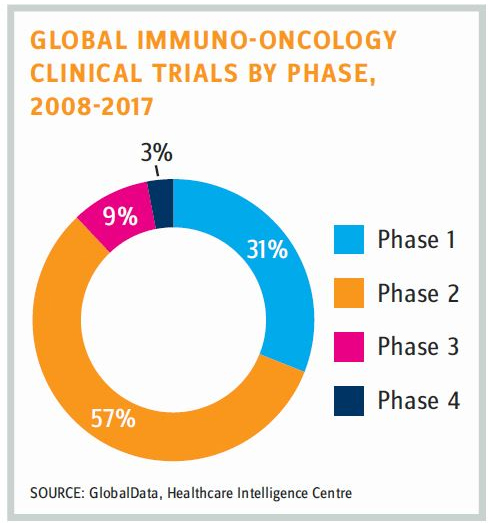Oncology Studies Show Pharma The Future Of Clinical Trials
By Ed Miseta, Chief Editor, Clinical Leader

At one time, a diagnosis of cancer was generally a death sentence for most patients. At the very least, it meant months of painful radiation treatments and chemotherapy. But today the treatment of cancer is evolving in ways that no one could have imagined just 20 years ago. Precision medicine is providing researchers with the ability to accurately match patients with the most effective treatment for their tumors. The resulting treatments, such as Merck’s KEYTRUDA, are now providing real hope to patients and allowing them to beat their cancers.
But what does the future hold for oncology trials, which now comprise around 80 percent of all clinical research? I spoke to three experts who shared their insights into where the industry is headed in 2019 and beyond.
 Martin Lehr, CEO at Context Therapeutics, a company focused on developing treatments for patients with hormone receptor positive cancers, believes sponsor companies need to increase their focus on China, a nation whose population (currently closing in on 1.5 billion) dwarfs that of the U.S. “The population of China is beginning to resemble the population of the U.S.,” says Lehr. “Historically, most westerners associated lung and liver cancer as being ‘Asian’ cancers. While those cancers are certainly more prevalent in China, you are seeing breast, prostate, and ovarian cancer rates quickly catching up with those of western countries. This may have to do with their diets beginning to look like the diets of western populations. With five times the number of potential cancer trial participants and those patients looking more and more ‘western,’ you have the potential for explosive growth of clinical trials in China. That is a fundamental change.”
Martin Lehr, CEO at Context Therapeutics, a company focused on developing treatments for patients with hormone receptor positive cancers, believes sponsor companies need to increase their focus on China, a nation whose population (currently closing in on 1.5 billion) dwarfs that of the U.S. “The population of China is beginning to resemble the population of the U.S.,” says Lehr. “Historically, most westerners associated lung and liver cancer as being ‘Asian’ cancers. While those cancers are certainly more prevalent in China, you are seeing breast, prostate, and ovarian cancer rates quickly catching up with those of western countries. This may have to do with their diets beginning to look like the diets of western populations. With five times the number of potential cancer trial participants and those patients looking more and more ‘western,’ you have the potential for explosive growth of clinical trials in China. That is a fundamental change.”
INVESTMENT PAVES THE WAY
China also has seen a massive influx of investment both in capital infusion and strategic business-development partnering. “I am seeing intensive interest on the part of companies wanting to do business in China,” says Lehr. “Sometimes trials will happen concurrently with an infusion of capital. Other times companies will start a trial in China with the hope of generating good data that will lead to interest from a potential partner and a possible deal. That is a trend that will definitely continue for the foreseeable future. The growth in China is also due in part to the Chinese government making clear that it wants to grow the pharmaceutical industry within that country. The government there has the ability to make that happen via decree.”
The changes the industry has seen over the last few years have been impressive. An increased focus on quality and the speeding up of regulatory timelines has caught the attention of the industry. For example, the National Medical Products Administration (NMPA) instituted a new policy in 2018 that expedited the approval process to just a 60-day waiting period, similar to the FDA’s IND period. Additionally, NMPA is now able to accept clinical data from international trials for new drug applications (NDAs). In 2017 alone, private equity and risk funds for Chinese startups in healthcare alone amounted to nearly $12 billion. In 2016, that figure was just $2.6 billion. Chinese drug companies also have raked in billions from equity markets and licensing agreements.
“China’s attempting to harmonize its regulatory pathways with those of the U.S. is good news for the industry,” says Lehr. “Altering its regulatory timelines was a fundamental change. Allowing companies in China to reference clinical data from other countries provides drug development firms with a fast path to regulatory approval. In the short term, that will certainly help accelerate the establishment of their industry. These are huge changes that only will increase drug development activity in China over time.”
COMBINATION TRIALS PRESENT OPPORTUNITIES AND CHALLENGES
Another trend we can expect to continue in 2019 and beyond is the growth in combination trials. “We have seen an increase in the number of products approved to treat oncology patients,” says Lehr. “With that increase in approvals we also will see an increase in the number of trials that hope to combine experimental treatments with those products. Unfortunately, that can create a cost issue if the sponsor is interested in a new cancer or subtype that is not covered in the approved medicine’s label. Even if the combinator medicine is covered, that takes control of the delivery of the product out of the hands of the companies conducting trials. That can increase the level of risk that exists in a trial.”
To deal with this issue, sponsor companies may have to purchase the drug or put some type of supply agreement in place with the owner of the drug. As a result, Lehr notes the number of supply agreements has increased dramatically in recent years. The situation creates both pros and cons.
For small companies, the supply agreements can be a hurdle that is difficult to overcome. Although such an agreement could eventually lead to positive trial results, some timely press coverage, and the purchase of your product, they do provide leverage to the larger companies and can be very time consuming to put in place. There is no real solution to the problem, although Lehr notes the government could use some type of stimulus to incentivize companies to provide drugs that are necessary for trials or find other ways to optimize the process.
“Merck, for example, has done many of these agreements,” says Lehr. “Therefore, unless your product seems to be remarkably different from another one that is already in clinical trials, there is little incentive for them to pursue a new supply agreement. Pharma companies or their contracting manufacturer would also have to have the excess capacity to produce more of the product. Remember, too, that these new treatments can be very expensive. If a company has to pay for the product, adding just 25 patients to a trial could increase the total trial cost by millions of dollars. There are many small companies that simply do not have the financial capital to make that kind of investment.”
MATCH PATIENTS TO THE RIGHT TRIALS
With the advances made in precision medicine, it is becoming increasingly important to properly match patients and their tumors to the right clinical trial. One technique that is assisting with that endeavor is companion diagnostics. A companion diagnostic is a diagnostic test used as a companion to a therapeutic drug to determine its applicability to a specific patient. In oncology, researchers will use the test to determine the amount of a particular protein expressed in patients. The test also can be used to exclude patient groups that will not likely benefit from treatment based on their biological characteristics.
The companion diagnostic most often will test for the existence of a protein in a patient’s tumor. Examples of companion diagnostics in breast cancer are the estrogen and HER2 receptors, which are used to identify patients who will likely benefit from hormone therapies or HER2 targeted approaches, respectively. The breast-cancer field has undoubtedly pushed the forefront of companion diagnostics.
“The upside of including a companion diagnostic is that it improves patient selectivity,” says Sandra Dunn, founder and CEO of Phoenix Molecular Designs, a company focused on finding a treatment for Triple Negative Breast Cancer. “The idea behind it is to personalize treatments for patients. I believe the tests are just one way that the industry is keeping pace with product development in oncology. Patients are reading about these new treatments, and they expect to be matched with the best available treatment. As an industry, we have to be ready to integrate the companion diagnostic piece of the puzzle.”
There is certainly a range of other tests that can be used to learn more about a person’s DNA and genomics, but a problem arises with the ability of companies to best use those results in trials. Dunn believes that with many tests, the technology we now have has outpaced the ability of the industry to translate those results into the clinic, resulting in a gulf between the two.
“There are many good examples of how companion diagnostics have made a real difference for patients. For example, in HER2-positive breast cancer, if a woman has the protein HER2 expressed in her tumor, the oncologist and patient are informed that she is a candidate for Herceptin or other therapies that block this receptor. That is a good example of how companion diagnostics can guide a treatment option.” says Dunn.
But there is also a downside to using companion diagnostics. It requires a high level of accuracy in the antibody and methods being employed. Debates over scoring criteria also arise and must be settled by consensus. Reproducibility across technical platforms is also a must. Overall, there is a tremendous amount of work that goes into getting companion diagnostics right and clinically implemented.
HELPING PATIENTS, FRUSTRATING CROs
When using a companion diagnostic, there is certainly a patient-centricity angle as well. When patients participate in a trial, there are several factors for them to consider. The trials take time, require patients to travel, and involve individuals spending time away from their jobs and families. They also require patients to undergo physical tests. By making sure every patient is the best fit for every trial, the industry can minimize the number of patients taking part in trials who do not benefit from the treatment and, moreover, hone the opportunity for those who will benefit.
Although the tests will benefit patients participating in trials, Dunn believes that not all clinical CROs are set up to accept the inclusion of companion diagnostics. “In oncology, we are seeing a huge demand for patients,” says Dunn. “Around 80 percent of clinical trials are in oncology, but we still have participation rates that hover around 5 percent. As we work to find a treatment for triple-negative breast cancer, there is increasing competition to recruit these patients for trials. When a patient comes through the door, there will be multiple trials that a clinic could refer them to. What patients will be looking for is their best chance at success. Companion diagnostics help to improve those odds.”

Developing precise cancer therapeutics is a goal met with high expectations. On the one hand, it relies on novel targeted approaches, and on the other, it depends on accuracy in identifying the patients who will receive the maximum benefit. This is where companion diagnostics play an essential role.
THE CHALLENGES OF GATHERING AND ANALYZING PATIENTS’ DATA
With the large number of ongoing oncology trials, and the limited number of patients participating in trials, getting the right patients for a study is a challenge every company faces. That is one of the many challenges Symantha Melemed, global product team and novel target leader — Oncology at Eli Lilly and Company, struggles with every day. She notes the company does well recruiting patients for pediatric cancer trials, but for adult oncology trials the participation rate still hovers around an abysmal 5 percent.
“One of the things we must all focus on as an industry is how to design better clinical trials that will generate the data we need with as few patients as possible,” says Melemed. “One thing that will help us to get better data from patients is advancements being made in digital health with the new wearable devices we are seeing. We are still early in the use of these devices, but I feel we are beginning to realize the impact they can have on patients and caregivers.”
Melemed believes payers and regulators will continue to ask for more information when it comes to new medicines and their impact on patients. Gathering that data will continue to be a challenge for researchers. Mobile and wearable devices are one way for them to receive a stream of valuable data from trial participants in a patient- friendly manner.
“Regulatory agencies are doing their best to help companies incorporate these devices into trials, but I feel we are still not 100 percent clear on how these devices will ultimately impact a drug label,” says Melemed. “In the digital health space, we also have an interesting convergence of tech companies. Many of them have not worked in the type of regulated environment we have in the life sciences.”
DATA ACCURACY REMAINS A CONCERN
Data gathered from mobile devices can be useful in oncology trials featuring new and experimental treatments. But the accuracy of the data being generated by mobile devices is certainly a concern. Melemed notes she wears both a Fitbit and an Apple Watch, and the data generated by them will often not match up. For example, when she is talking to someone and moving her hands a lot, the Fitbit will record steps. But even more important is their classification. If the data collected will be used to impact patient care, these activity trackers would be considered a medical device and subject to FDA’s device regulations.
Melemed believes the companies that will make a splash in this space are the ones that will recognize the regulatory interests of the FDA and think about the privacy concerns currently being addressed in Europe. She is also concerned that many of the devices currently being used have data going through their own proprietary systems.
“They are concerns we will have to deal with, but I’m excited by how these technologies are advancing and what they are able to do with passive monitoring,” states Melemed. “The new Apple Watch can perform an EKG. These devices can now measure sleep patterns, which is a big improvement over the questionnaires that we currently use. There are other devices that can now measure blood pressure and body temperature, which are helpful in allowing us to understand the condition of patients and monitor them for adverse events.”
COMBINE ACTIVE AND PASSIVE DATA
We are seeing increased use of patient reported outcomes (PROs) in clinical trials. Unfortunately, that information is often gathered via paper forms filled out in a physician’s office. Digital devices can provide better information than what is recorded on paper, and can do it in real time. If a patient enrolled in an oncology trial is providing information on a treatment’s side effects throughout the day (i.e. nausea or diarrhea), physicians also can react much more quickly.
“When you combine those active and passive data sets, you start to see correlations between adverse events and things like body temperature and heart rate,” says Melemed. “That information could allow us to alert healthcare professionals of possible events before they even become apparent in patients. Those are things that won’t happen until sometime in the future, but we can already start to see how these new technologies are moving us in that direction.”
In the past, a cancer patient would come to their physician stating that they feel worse. Tests and scans would later confirm that the disease has progressed. Melemed foresees a day when the combination of active monitoring, passive monitoring, and electronic health records will allow researchers to predict disease progression before it happens, allowing them to adjust therapies if necessary.
